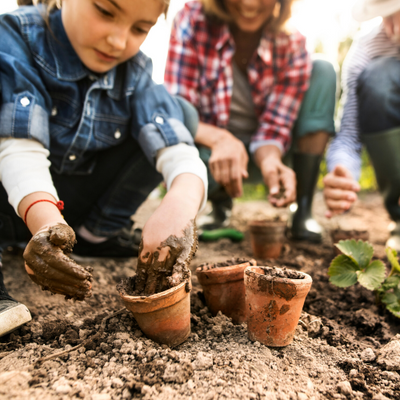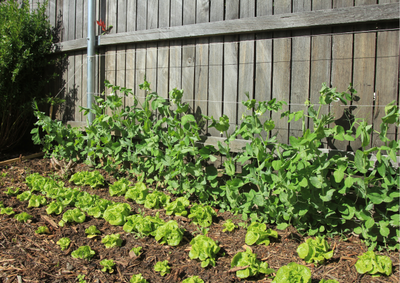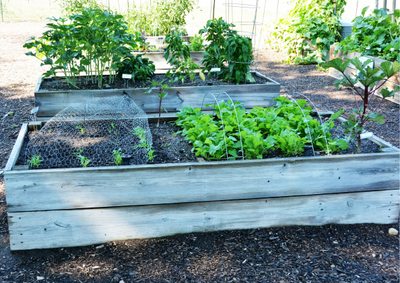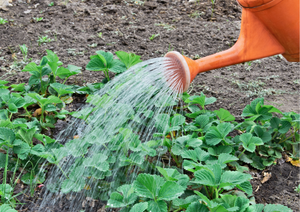Garden placement and design
by Bruce Beamish, Cancer Council WA Regional Education Officer for the Great Southern
- July 28, 2020
- Leave a comment

If you have a windowsill, you immediately have enough space for a couple of pots of herbs. If you have more space, then there are creative possibilities only limited by your imagination: a sunny courtyard or balcony can be filled with pots, a fence can be covered with vertical gardens, and a backyard can be home to a more traditional garden. There are even options for small self-contained indoor growing.
One rule of thumb - particularly if you are new to edible gardens - is to start small and work up. Starting small gives you the opportunity to assess how much work is involved, and to find out what works and what doesn’t before you commit to a big project.
The beauty of the home vegetable garden is that it can just as easily be a research project or an art project. Here’s some things to take into account when you’re designing your vegie patch.
Placement
 Spend time watching the way the sunlight hits the garden, and the way shadows fall. Most vegetables prefer full or partial sun, and morning sun is preferable to afternoon sun. Also remember that the way the sun falls on your growing space is going to be different from summer to winter.
Spend time watching the way the sunlight hits the garden, and the way shadows fall. Most vegetables prefer full or partial sun, and morning sun is preferable to afternoon sun. Also remember that the way the sun falls on your growing space is going to be different from summer to winter.
Where possible, protect your plants from strong winds – hardier plants or hedges, or screening materials like bamboo or wicker panels can be useful to keep your plants out of the bluster.
Shape and form
It can be full of straight lines, or curves, or a mixture of the two. You’re only limited by your imagination (and perhaps your budget). A little planning goes a long way. Try doing a rough sketch to help you figure out what you have, what you like and what you can do with the space you have.
Keep ‘em close
Place plants that you use frequently closer to your door - it’s great to have herbs close and handy while cooking whereas things that are harvested once a year can be further away. There’s so much pleasure in being able to duck out the door while cooking to “just grab something” to add to a dish. It also impresses dinner guests no end!
Choose your materials
Be creative with the materials you have at hand. A home garden is an amazing place to reuse or salvage materials such as old tanks, drums, timber, recycled bricks, plastic or glass bottles, foam boxes. The list is near-endless, and there are plenty of resources and examples online of beautiful and functional gardens built from recycled materials.
Raise it up
 Raised garden beds are great – by placing a garden bed on top of the existing ground level you can fill them with your choice of soil right from the start. As they’re higher than the surrounding ground, you also don’t have to bend or kneel to weed or plant, they provide great drainage, and can be built from a wide range of new or recycled materials. Hot tip: make sure they are not too wide so you can reach all parts of the bed whilst standing on firm ground.
Raised garden beds are great – by placing a garden bed on top of the existing ground level you can fill them with your choice of soil right from the start. As they’re higher than the surrounding ground, you also don’t have to bend or kneel to weed or plant, they provide great drainage, and can be built from a wide range of new or recycled materials. Hot tip: make sure they are not too wide so you can reach all parts of the bed whilst standing on firm ground.
Consider using vertical spaces. A north facing wall or fence can make a great support for climbing plants such as beans or peas, or you can build a structure for strawberries. If your planting area is windy, then more hardy species can be stacked vertically to shelter less-hardy ones.
Paths and walkways
Having clear defined places to walk is important, so choose something that compliments your garden and style. Try recycled brick paving, gravel or stone, weed matting - or even growing a patch of annual grasses and herbs that can be used as green manure. No matter your choice, make sure it’s easy to maintain and there are no trip or mobility hazards.
Water wise
 It’s (hopefully obviously) important to consider how you will water your plants. All plants need water, but vegetables and fruit really benefit from consistent watering. Erratic watering can lead to stunted growth, split fruits and disappointment. An automatic watering system installed during construction can save much time and water. There are also advantages to hand watering. It can give you time to observe your garden, create a greater connection and is a wonderful exercise in mindfulness and stress relief.
It’s (hopefully obviously) important to consider how you will water your plants. All plants need water, but vegetables and fruit really benefit from consistent watering. Erratic watering can lead to stunted growth, split fruits and disappointment. An automatic watering system installed during construction can save much time and water. There are also advantages to hand watering. It can give you time to observe your garden, create a greater connection and is a wonderful exercise in mindfulness and stress relief.
The beauty of gardening is the flexibility to make the garden fit your needs. We hope you enjoy the whole process. We’d love to hear about how your garden grows! Tag the LiveLighter Campaign in your socials (on Facebook, Instagram and Twitter). We’ve also got loads more tips about gardening over here.







